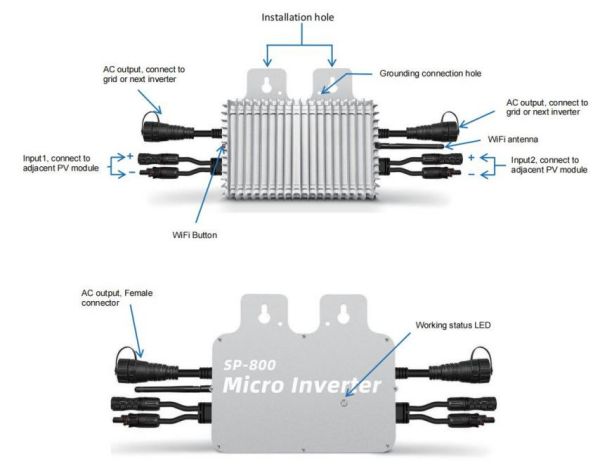The full name of the micro-inverter is the micro solar grid-tied inverter. It is mainly used in photovoltaic power generation systems and generally refers to inverters and module-level MPPTs with a power rating of less than 1500W. Micro-inverters are relatively small in size compared to conventional centralized inverters. Micro-inverters invert each module individually. The advantage is that each module can be controlled independently by MPPT. This greatly improves the overall efficiency. At the same time, micro-inverters can avoid the problems of high DC voltage, poor light efficiency, and barrel effect of central inverters.
Micro-inverters manage the collection of solar energy on individual panels to increase the efficiency of the solar installation, rather than working across the entire system as a central inverter would. In the past, the complex control mechanisms used to ensure maximum performance during solar collection have increased costs and limited the uptake of micro-inverters. Integrated circuit and processor-based solutions are both sophisticated and cost-effective to handle the logic control of micro-inverter designs. Various voltage controllers and regulators also provide complementary solutions for generating power from the DC output of solar panels.
In a simple micro-inverter design, an interleaved active clamped flyback inverter improves the low voltage DC voltage from the solar panel and the high voltage AC waveform required by the grid.
Like power supply design, micro-inverter design requires various techniques to improve efficiency and reliability. An interleaved flyback topology is used, which helps to reduce the rms ripple current through them, thereby extending the life of the electrolytic capacitors in these designs. In addition, the use of active clamping techniques allows a higher maximum duty cycle, enabling the use of higher turns ratios. This can significantly reduce the current load on the primary side and the voltage load on the secondary side.
To ensure maximum energy output, the inverter must be able to respond to the micro-inverter’s control logic. This logic is designed to keep the voltage and current of the converter as close as possible to the desired characteristics produced by the MPPT algorithm. More importantly, grid-connected micro-inverters must be able to disconnect from the grid in the event of a power failure. These fault protection features, in turn, require the inverter to have at least overvoltage and undervoltage detection.
The design of micro-inverters imposes control, power conversion and efficiency requirements that have limited their widespread use in the past. However, with the proliferation of integrated solutions, designers can use a variety of suitable devices. While dedicated processors can provide the advanced control features and MPPT functionality required for micro-inverters, designs for the power conversion stage require devices that can safely and efficiently deliver the performance and functionality required for the grid. With a wide range of integrated switching regulators and PMICs available, engineers can create efficient, cost-effective power conversion stages in micro-inverter designs.
Post time: Aug-31-2023
